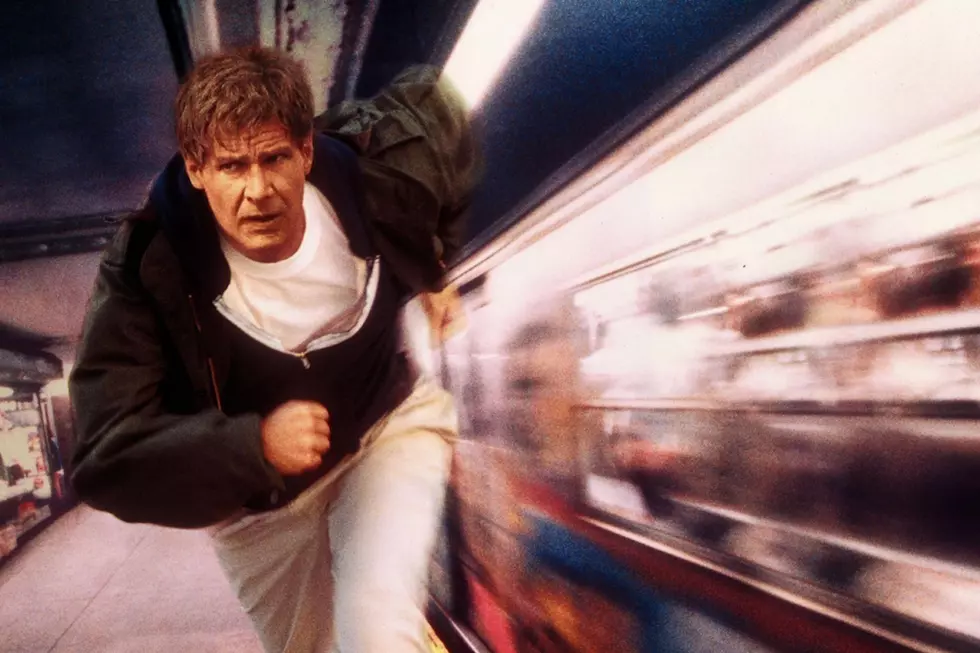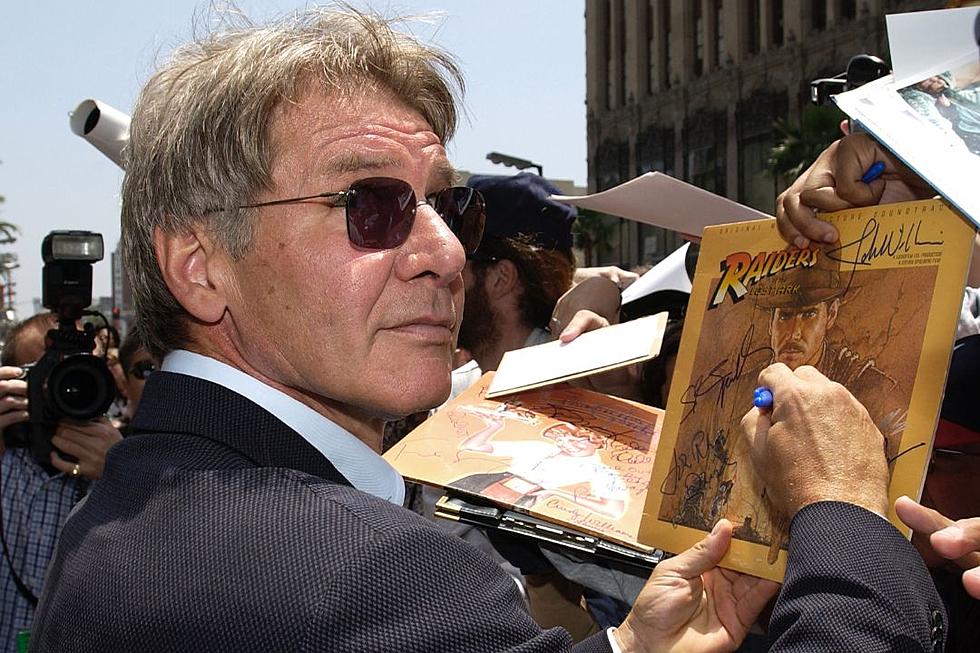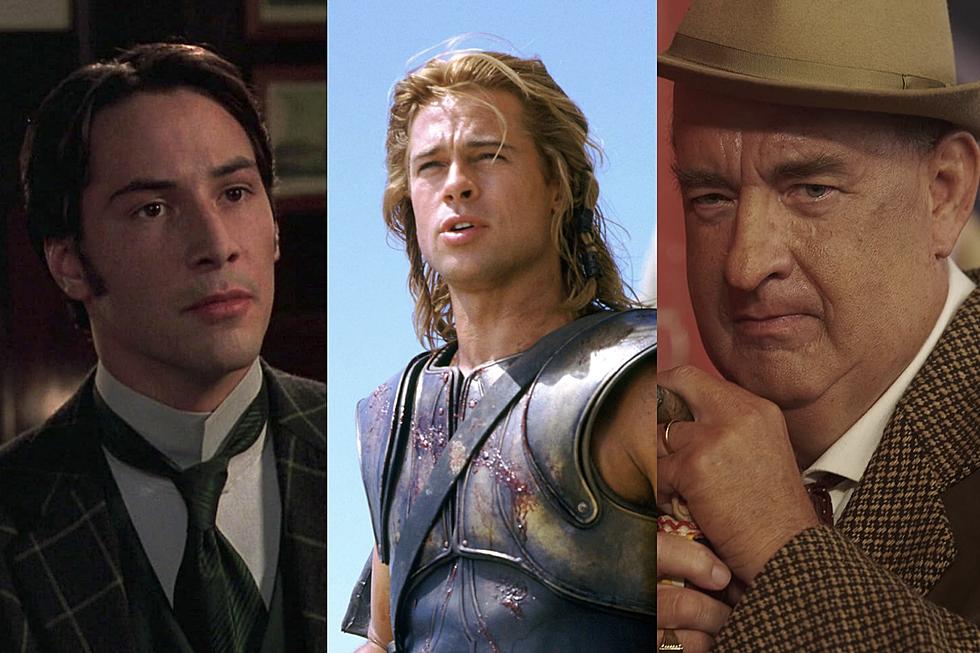
‘The Fugitive’ Is the Best Summer Blockbuster of the 1990s
There are different opinions about what constitutes a work of “pure cinema.” The phrase suggests the art of moviemaking distilled down to its essence. But what constitutes that essence? That’s where opinions differ.
I find general definitions are less useful than practical applications. My favorite bit of pure cinema, the image I would put in an encyclopedia to illustrate the term, is Tommy Lee Jones in The Fugitive, when he makes a dismissive wiggle with his head as he says the word “doctor” in the line “Your fugitive’s name is Doctor Richard Kimble.”
That little jiggle represents the apex of pure visual storytelling. It tells you everything you need to know about Jones’ Deputy Marshal Sam Gerard in a fraction of a second. Gerard’s target (Doctor Richard Kimble) gets the first 20 minutes of The Fugitive all to himself. We learn about his relationship with his wife, her sudden and shocking murder, and Kimble’s reaction to this horrible tragedy. We see how he reacts to her death, and to the realization that with no exculpatory evidence, he is the prime suspect for the crime. After he’s convicted, we also see how he risks his own life to save an injured guard after the bus carrying him to prison crashes. The sum of all of these scenes, actions, and lines explains who Kimble is.
Gerard shows up after the bus crash when Kimble goes on the run; in contrast to all the setup in the previous paragraph, the film has just moments to explain who this guy is. The “Doctor Richard Kimble” does it. Combined with the scene around it, it shows what kind of marshal he is, and how he leads his team. The head jiggle also tells us Gerard isn’t impressed by job titles. In his line of work, they mean nothing. “Oh you’re a doctor? Good for you. Guess what? In my eyes, you’re still a killer.”
The guy we see in that scene matches perfectly with the one in The Fugitive’s most famous sequence, when Gerard catches Kimble in a drain pipe and he protests “I didn’t kill my wife!” Without missing a beat, Gerard replies “I don’t care!”
Jones won an Oscar for Best Supporting Actor for his performance in The Fugitive. He deserved it. The film received seven Oscar nods overall; 25 years later, it’s still the only film based on a TV series to earn a Best Picture nomination. (It wound up losing to Schindler’s List.) That’s just one of the ways The Fugitive is like a Hollywood unicorn. It was the rare summer movie that became a serious awards contender. It was a craven attempt to generate a nostalgic cash-in that somehow produced a true work of pop art. On its 25th anniversary it stands as perhaps the best summer entertainment of the entire 1990s.
It’s also got to be the most impressive condensation of a TV series into a single, standalone movie ever. The Fugitive TV show aired for four seasons through the mid and late 1960s, following Dr. Richard Kimble (David Janssen) as he tries to stay ahead of Lieutenant Philip Gerard (Barry Morse) while pursuing the one-armed man who killed his wife. On television, The Fugitive only occasionally addressed its central story. It used its premise as the basis for an anthology series where each week Dr. Kimble wandered to a new town and got mixed up in the lives of the locals.
In the series finale, Kimble finally found the one-armed man and proved his innocence. Today, the film is better remembered than the show (partly because the show aired 50 years ago) but in its day, the finale was the most-watched episode of a TV series up to that time, with an astounding 78 million people tuning to see if Dr. Kimble finally cleared his name. (SPOILER ALERT: He did.)
The film version compressed four years into 130 minutes. This Kimble (Harrison Ford) goes straight from his daring escape (leaping from the wreckage of a bus crash before it’s demolished by a speeding train) to his hunt for the one-armed man. Still, even with a drastically reduced amount of time to play with director Andrew Davis managed to cram an impressive variety of genres into the film: The Fugitive is by turns an action movie, a thriller, a prisoner-on-the-run movie, a revenge film, a police procedural, and a medical mystery.
It would be tough for any movie to juggle all those different moods and tones, but The Fugitive blends them together seamlessly, a feat that’s even more impressive when you learn it is the product of not one, not two, not even three, but six credited editors. (The Fugitive is also the only film in Oscar history nominated for Best Film Editing with that many credited editors.)
Somehow all those men managed to work together to create a consistently breathless pace; The Fugitive is one of the modern thrillers that can hold its own with Alfred Hitchcock masterpieces. Time after time, Ford’s Kimble is seconds or inches away from getting caught before making another improbable escape, like in this scene, where he passes down a flight of stairs moments before Gerard comes up on the opposite side and you think he’s gotten away, but then Gerard doubles back, prompting yet another intense foot chase.
There are some deft special effects in the bus-and-train crash sequence, but a lot of The Fugitive’s action is as simple as shoe-leather: One man chasing another man. The overall structure, though, is a double chase; one man chasing another man who’s on the hunt for a third person who may not even exist. That’s particularly pleasing construction — the movie alternates between Kimble the target and Kimble the detective — because we never stay in any one mode long enough for it to get stale. Every 15 minutes there’s a new twist or turn.
Watching The Fugitive for the first time in many years ahead of its 25th anniversary, I was blown away by how much I remembered, down to lines (“The guy is fish food!” “Fine. Go get a cane pole, catch the fish that ate him!”) and even gestures. It dawned on me that while I’ve never owned The Fugitive on any home video format, thanks to endless airings on cable during my teenage years, I have seen The Fugitive dozens of time, more than all but a handful of films I have on Blu-ray or DVD.
That’s because it might be the most perfect movie to watch on basic cable at 4PM on a Saturday afternoon ever created. It has all five of my hallmarks of a cable classic. They are:
- Something interesting has to happen every 12 minutes, so that each segment between commercial breaks is satisfying.
- Scenes you can anticipate and look forward to rewatching. By my count, are at least seven all-time great sequences. (The bus/train crash, Jones’ introduction w/ head bobble, the sewer chase, Kimble saves the kid in the hospital, the St. Patrick’s Day scene, Kimble interrupts Dr. Nichols speech, the final battle)
- At least one training montage. (Kimble sneaking into a hospital and searching through the prosthesis department records to find the one-armed man.)
- Supporting roles by people who would later go on to become extremely famous. (Julianne Moore, Jane Lynch, and future NBC News anchor Lester Holt.)
- An extremely hummable score.
Just try not to start searching hospital databases for one-armed men while you listen to this thing. It‘s the perfect music to do some hot computer research to:
I could literally go on for another 1,000 about all the little things I love about this movie: How it starts with a scruffy out-of-shape Harrison Ford in suspenders and slowly morphs him into an action hero; the homage to the TV show’s structure in Kimble briefly taking a job as a janitor and then helping a dying boy by changing his hospital chart; the way a nightmare ends with him yelling “You find that man!” to the police which then becomes an order to himself; that’s when he stops blindly running for his life and starts searching for the one-armed man. I love how the movie starts post-murder to hurry us to the best parts of the story, and how the ending upends the characters’ allegiances one last time so that Gerard now knows Kimble is innocent but the entire Chicago Police Department thinks he’s a cop killer.
IMDb claims shooting on The Fugitive began without a finished script, a shocking fact in light of the film’s clever turns and propulsive narrative momentum. If that’s true, it makes The Fugitive even more of a miracle, one that has aged, in spite of its sometimes questionable production methods, into a exemplary work of its genre and era, filled with tiny nuggets of pure cinema like Tommy Lee Jones’ bobblehead move.
Gallery - 16 of the Most Expensive Blockbusters Ever Made:
More From ScreenCrush
![Harrison Ford’s Spectacular $20 Million California Estate For Sale — See Inside! [Pictures]](http://townsquare.media/site/204/files/2024/04/attachment-harrison-ford-house-for-sale-pictures.jpg?w=980&q=75)








